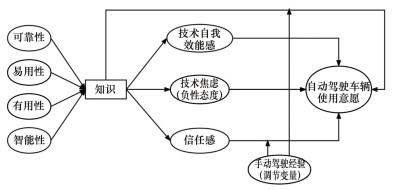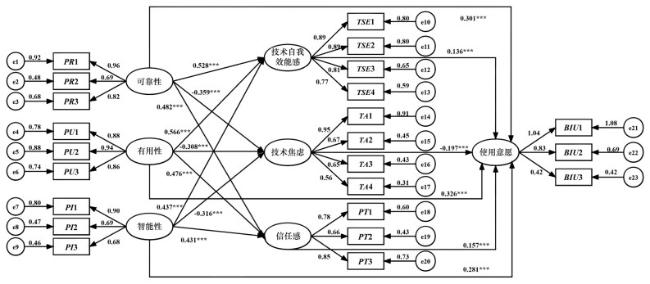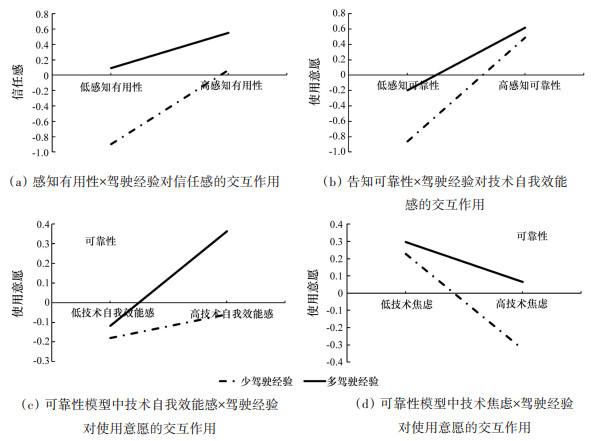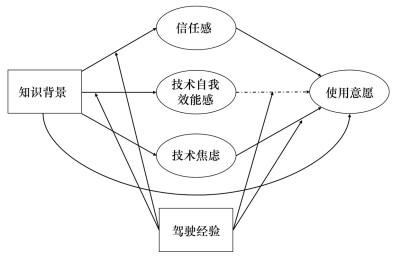1 文献综述
1.1 自动驾驶技术知识背景的影响
1.2 知识背景引发的心理感受及其对于使用意愿的影响
2 研究模型与研究假设
2.1 研究模型
2.2 研究假设
3 研究方法
3.1 被试
表1 受测者的人口学变量统计情况 |
| 变量 | 人数/人 | 百分比/% | |
| 性别 | 男 | 328 | 51.8 |
| 女 | 305 | 48.2 | |
| 年龄 | 18~23岁 | 273 | 43.1 |
| 24~26岁 | 248 | 39.2 | |
| 27~30岁 | 112 | 17.7 | |
| 驾照持有情况 | 没有驾照 | 75 | 11.8 |
| 持有6个月以下 | 93 | 14.7 | |
| 持有6~12个月 | 201 | 31.8 | |
| 持有1~5年(不含) | 205 | 32.4 | |
| 持有5年及以上 | 59 | 9.3 | |
| 每周开车天数 | 不开车 | 111 | 17.5 |
| 1~2 d | 110 | 17.4 | |
| 3~4 d | 129 | 20.4 | |
| 5~6 d | 141 | 22.3 | |
| 每天都开 | 142 | 22.4 | |
| 自动驾驶车辆了解情况 | 从未听说 | 3 | 0.5 |
| 听说过但未实际接触 | 212 | 33.3 | |
| 乘坐过带有自动驾驶辅助系统的车辆 | 230 | 36.2 | |
| 购买过带有自动驾驶辅助系统的车辆 | 191 | 30.0 | |
3.2 研究方法
表2 各变量测量量表 |
| 变量 | 观测条目 |
| 感知有用性(PU) | PU1:自动驾驶汽车在满足我的交通需求方面很有用 |
| PU2:自动驾驶汽车使驾驶变得更加简单高效 | |
| PU3:使用自动驾驶汽车驾驶会更有趣 | |
| 感知易用性(PEU) | PEU1:学习操作自动驾驶汽车对我来说很容易 |
| PEU2:与自动驾驶汽车的交互对我来说是清晰易懂的 | |
| PEU3:对我来说,熟练使用自动驾驶汽车是很容易的 | |
| 感知可靠性(PR) | PR1:使用自动驾驶汽车已经比手动驾驶更安全了 |
| PR2:使用自动驾驶汽车会减少交通事故 | |
| PR3:自动驾驶汽车能够减少对环境的影响 | |
| 感知智能性(PI) | PI1:自动驾驶汽车能够在任何环境下安全运行,无需驾驶员的协助 |
| PI2:驾驶员辅助系统将逐渐发展为全自动汽车 | |
| PI3:目前已经实现了无人驾驶 | |
| 技术焦虑(TA) | TA1:当我必须使用自动驾驶汽车来完成驾驶任务时,我会感到不安 |
| TA2:在人前使用自动驾驶汽车时,我会感到紧张 | |
| TA3:如果我过于依赖自动驾驶汽车,可能会导致一些坏事的发生 | |
| TA4:我担心自动驾驶汽车无法响应我的指令 | |
| 技术自我效能感(TSE) | TSE1:当没有人告诉我使用方法时,我能够使用自动驾驶汽车完成既定目标 |
| TSE2:如果有使用说明书,我能使用自动驾驶汽车完成既定目标 | |
| TSE3:如果有内置的辅助工具,我能使用自动驾驶汽车完成既定目标 | |
| TSE4:如果在使用时遇到困难可以求助他人,我能使用自动驾驶汽车完成既定目标 | |
| 信任感(PT) | PT1:我能够信任自动驾驶汽车 |
| PT2:我对使用自动驾驶汽车没有顾虑 | |
| PT3:自动驾驶汽车的安全性是值得信赖的 | |
| 使用意愿(BIU) | BIU1:当自动驾驶汽车上市时,我愿意购买它们 |
| BIU2:我愿意乘坐或使用自动驾驶汽车 | |
| BIU3:我会推荐我的亲朋好友使用自动驾驶汽车 |
3.3 数据处理方法
4 数据分析结果
4.1 研究工具的有效性检验
表3 信度及聚合效度分析 |
| 维度 | 观测变量 | 信度 | 聚合效度 | ||||
| Cronbach α系数 | 删除项后的Cronbach α系数 | 因子载荷 | AVE | CR | |||
| 感知有用性(PU) | PU1 | 0.922 | 0.612 | 0.913 | 0.800 | 0.923 | |
| PU2 | 0.612 | 0.939 | |||||
| PU3 | 0.613 | 0.909 | |||||
| 感知易用性(PEU) | PEU1 | 0.829 | 0.632 | 0.826 | 0.658 | 0.850 | |
| PEU2 | 0.617 | 0.848 | |||||
| PEU3 | 0.628 | 0.924 | |||||
| 感知可靠性(PR) | PR1 | 0.863 | 0.624 | 0.927 | 0.693 | 0.869 | |
| PR2 | 0.608 | 0.829 | |||||
| PR3 | 0.630 | 0.893 | |||||
| 感知智能性(PI) | PI1 | 0.796 | 0.622 | 0.877 | 0.578 | 0.801 | |
| PI2 | 0.636 | 0.828 | |||||
| PI3 | 0.619 | 0.806 | |||||
| 技术焦虑(TA) | TA1 | 0.800 | 0.626 | 0.898 | 0.526 | 0.810 | |
| TA2 | 0.630 | 0.768 | |||||
| TA3 | 0.628 | 0.784 | |||||
| TA4 | 0.616 | 0.701 | |||||
| 技术自我效能感(TSE) | TSE1 | 0.904 | 0.625 | 0.909 | 0.709 | 0.907 | |
| TSE2 | 0.625 | 0.908 | |||||
| TSE3 | 0.628 | 0.863 | |||||
| TSE4 | 0.619 | 0.846 | |||||
| 信任感(PT) | PT1 | 0.805 | 0.631 | 0.855 | 0.588 | 0.809 | |
| PT2 | 0.623 | 0.807 | |||||
| PT3 | 0.628 | 0.877 | |||||
| 使用意愿(BIU) | BIU1 | 0.796 | 0.633 | 0.941 | 0.643 | 0.831 | |
| BIU2 | 0.634 | 0.910 | |||||
| BIU3 | 0.635 | 0.632 | |||||
4.2 结构方程模型的建立
表4 相关路径系数检验 |
| 假设 | 路径 | β | 是否验证假设 |
| H1 | PU→BIU | 0.188*** | 是 |
| PEU→BIU | 0.069 | 否 | |
| PR→BIU | 0.175*** | 是 | |
| PI→BIU | 0.239*** | 是 | |
| H2 | TA→BIU | 0.081* | 是 |
| TSE→BIU | 0.023 | 否 | |
| PT→BIU | -0.158*** | 是 | |
| H3 | PU→TA | -0.057 | 否 |
| PEU→TA | 0.021 | 否 | |
| PR→TA | -0.153*** | 是 | |
| PI→TA | -0.209*** | 是 | |
| H4 | PU→TSE | 0.245*** | 是 |
| PEU→TSE | 0.110** | 是 | |
| PR→TSE | 0.191*** | 是 | |
| PI→TSE | 0.138*** | 是 | |
| H5 | PU→PT | 0.139*** | 是 |
| PEU→PT | 0.113** | 是 | |
| PR→PT | 0.175*** | 是 | |
| PI→PT | 0.199*** | 是 |
注:*p < 0.05;**p < 0.01;***p < 0.001。 |
表5 调整后模型的相关路径系数检验 |
| 假设 | 路径 | β | 是否验证假设 |
| H1 | PU→BIU | 0.326*** | 是 |
| PR→BIU | 0.301*** | 是 | |
| PI→BIU | 0.281*** | 是 | |
| H2 | TSE→BIU | 0.136*** | 是 |
| PT→BIU | 0.157*** | 是 | |
| TA→BIU | -0.197*** | 是 | |
| H3 | PU→TA | -0.308*** | 是 |
| PR→TA | -0.359*** | 是 | |
| PI→TA | -0.316*** | 是 | |
| H4 | PU→TSE | 0.566*** | 是 |
| PR→TSE | 0.528*** | 是 | |
| PI→TSE | 0.437*** | 是 | |
| H5 | PU→PT | 0.476*** | 是 |
| PR→PT | 0.482*** | 是 | |
| PI→PT | 0.431*** | 是 |
注:*p < 0.05;**p < 0.01;***p < 0.001。 |
表6 中介效应检验 |
| 效应值 | 标准误 | p | 95% 置信区间 | 假设验证情况 | |
| PU→TA→BIU | 0.055 | 0.014 | < 0.001 | [0.032, 0.085] | H3 |
| PU→TSE→BIU | 0.054 | 0.028 | 0.035 | [0.004, 0.113] | H4 |
| PU→PT→BIU | 0.067 | 0.023 | 0.008 | [0.023, 0.111] | H5 |
| PR→TA→BIU | 0.054 | 0.014 | < 0.001 | [0.029, 0.085] | H3 |
| PR→TSE→BIU | 0.059 | 0.024 | 0.007 | [0.016, 0.109] | H4 |
| PR→PT→BIU | 0.061 | 0.021 | 0.004 | [0.023, 0.102] | H5 |
| PI→TA→BIU | 0.060 | 0.016 | < 0.001 | [0.031, 0.094] | H3 |
| PI→TSE→BIU | 0.067 | 0.024 | 0.004 | [0.023, 0.118] | H4 |
| PI→PT→BIU | 0.063 | 0.023 | 0.010 | [0.019, 0.110] | H5 |
4.3 有调节的中介模型检验
表7 驾驶经验在感知有用性模型中的调节作用 |
| 交互项 | 预测变量 | 指标 | 少驾驶经验 | 多驾驶经验 |
| 感知有用性×驾驶经验 | 技术自我效能感 | β | 0.624 | 0.342 |
| t, p | 13.365, < 0.001 | 6.563, < 0.001 | ||
| 置信区 | [0.532, 0.715] | [0.240, 0.444] | ||
| 感知有用性×驾驶经验 | 信任感 | β | 0.458 | 0.218 |
| t, p | 9.580, < 0.001 | 4.081, < 0.001 | ||
| 置信区 | [0.364, 0.552] | [0.113, 0.323] | ||
| 技术焦虑×驾驶经验 | 使用意愿 | β | -0.267 | -0.117 |
| t, p | -5.340, < 0.001 | -2.412, 0.016 | ||
| 置信区 | [-0.364, -0.169] | [-0.213, -0.022] | ||
| 技术自我效能感×驾驶经验 | 使用意愿 | β | 0.016 | 0.195 |
| t, p | 0.264, 0.791 | 3.368, < 0.001 | ||
| 置信区 | [-0.104, 0.135] | [0.081, 0.309] |
表8 驾驶经验在感知可靠性模型中的调节作用 |
| 交互项 | 预测变量 | 指标 | 少驾驶经验 | 多驾驶经验 |
| 感知可靠性×驾驶经验 | 技术自我效能感 | β | 0.578 | 0.349 |
| t, p | 10.944, < 0.001 | 7.223, < 0.001 | ||
| 置信区 | [0.475, 0.682] | [0.254, 0.444] | ||
| 感知可靠性×驾驶经验 | 信任感 | β | 0.478 | 0.257 |
| t, p | 9.126, < 0.001 | 5.374, < 0.001 | ||
| 置信区 | [0.375, 0.581] | [0.163, 0.352] | ||
| 技术焦虑×驾驶经验 | 使用意愿 | β | -0.247 | -0.103 |
| t, p | -4.791, < 0.001 | -2.098, 0.036 | ||
| 置信区 | [-0.348, -0.145] | [-0.200, -0.007] |
表9 驾驶经验在感知智能性模型中的调节作用 |
| 交互项 | 预测变量 | 指标 | 少驾驶经验 | 多驾驶经验 |
| 感知智能性×驾驶经验 | 技术自我效能感 | β | 0.579 | 0.261 |
| t, p | 10.345, < 0.001 | 5.093, < 0.001 | ||
| 置信区 | [0.469, 0.689] | [0.160, 0.361] | ||
| 感知智能性×驾驶经验 | 信任感 | β | 0.444 | 0.268 |
| t, p | 8.112, < 0.001 | 5.345, < 0.001 | ||
| 置信区 | [0.337, 0.551] | [0.169, 0.366] | ||
| 技术焦虑×驾驶经验 | 使用意愿 | β | -0.239 | -0.091 |
| t, p | -4.695, < 0.001 | -1.845, 0.066 | ||
| 置信区 | [-0.348, -0.145] | [-0.188, 0.006] | ||
| 技术自我效能感×驾驶经验 | 使用意愿 | β | 0.036 | 0.244 |
| t, p | 0.622, 0.534 | 4.311, < 0.001 | ||
| 置信区 | [-0.078, 0.150] | [0.133, 0.350] |














